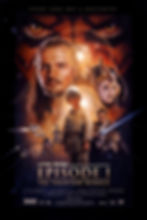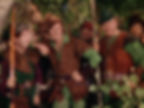American Illustrators, The Movies, and Drew Struzan
- Brian Watt
- Mar 20, 2018
- 6 min read

Much like the word “genius,” the label “artist” gets bandied about quite a bit. When I was taking fine art classes in college, one of the more colorful and exuberant life drawing and painting instructors — let’s call him Charlie — a very hyperactive and passionate painter, talked to us about what it meant to be an artist.
“So you all want to be artists, huh?” He shouted as he strutted in and around our rows of easels as we worked. “I’m just here to teach you how to paint and hopefully paint well. I can’t teach you to be an artist. An artist is a way of life, man. Are you willing to starve for your art? Are you in it for the money? Van Gogh sold one painting in his life. He went mad and then committed suicide. He was an artist. Are you willing to let it consume you? Let’s just concentrate on painting for now.”

Now, I’ve always been fascinated by illustrators who were adept at rendering the human form, faces, and textures were able to put their subjects into fascinating settings and conjure up just the right mood. I had a knack — still do, though not so much practiced of late — of being able to capture likenesses fairly well when I drew. The best illustrators and painters are very talented at drawing and their pen and pencil work alone is worthy of collecting. Without a foundation in accurate lifelike drawing a lot of paintings and illustrations meant to be realistic tend to look less real, less lifelike and dull.

In America, there have been several periods where talented illustrators emerged. In the 1910s, 20s and 30s, the works of Maxfield Parrish, J.C. Leyendecker, Norman Rockwell, N.C. Wyeth, and Howard Pyle (to name just a few), adorned the covers of Collier’s, the Saturday Evening Post, or in Wyeth’s case numerous works of literature: The White Company, Robin Hood, Treasure Island, Robinson Crusoe, and The Last of the Mohicans.
Sometimes, these talented men worked on a grand scale – many of them, like Wyeth and Parrish were commissioned to do large murals — and much of their work for magazine covers, stories, and book covers were originally painted much larger and reproduced much smaller for print. When I worked at Stanford, helping to put out the Stanford Daily back in the early 1980s, I happened upon an exhibit of N.C. Wyeth’s work at a small gallery in Palo Alto and was awestruck by one of the paintings he had done to illustrate Robin Hood, depicting the outlaw’s band of merry men crouched behind the base of a massive oak tree with their bows pulled back waiting to let their arrows fly. The texture and color of the grass and the men’s costumes looked as rich and fresh as if it had all been painted yesterday. My recollection was that the work was enormous but time has a tendency to romanticize and embellish the truth. In fact the work is an oil on canvas about 40 inches tall and 32 inches wide; i.e., about the size of a standard movie poster (though five inches wider). And the painting was actually for sale at the time for about $25,000 and I dreamed of owning it one day. I still dream.

It seems obvious that the work of some of these illustrators influenced the look of many films especially during Hollywood’s Golden Age 1930s and 1940s and even today. I don’t know how you can look at The Adventures of Robin Hood (1938) with Errol Flynn, Olivia de Haviland, Claude Raines, Basil Rathbone, for example and not see the influence of N.C. Wyeth’s 1917 work for the Robin Hood story in the sets, the costumes and even the use of color of the film.

The 1950s saw another wave of young talented illustrators often tasked with creating work for the covers of pulp fantasy and science fiction or adventure novels and short stories by Isaac Azimov, Philip K. Dick, Edgar Rice Burroughs, and Robert E. Howard. One of the illustrators to gain prominence during this period was Frank Frazetta, a street smart Brooklyn, New York kid who developed a reputation for conjuring up gothic, fantasy paintings that often included a shapely semi-nude or very nude, buxom and posteriorly-endowed woman prominently placed in the foreground of the piece with a dragon, bear, tiger that the woman had tamed, or a demon from Hell that had enslaved her or is about to enslave her. Enticing and alluring stuff for teenage boys and much more fun to look at than the articles in Boys Life or The Readers Digest…and oh, so beautifully rendered.
The image of the seductively and scantily-clad Princess Leia, chained in front of Jabba the Hut in the opening scenes of Return of the Jedi is an homage to the work of Frank Frazetta.



Drew Struzan is part of the next wave of fine American illustrators. He is an illustrator, a master draftsman, a devoted husband, father and grandfather, and an artist. Despite his talent and the many admirers he has in the film industry — Lucas, Spielberg, Harrison Ford, Daranbot, del Toro and others — Mr. Struzan is very soft-spoken, respectful, and humble man. He’s for the most part retired and spends more of his time with his family now enjoying the fruits of his labor, occasionally doing some art for friends or former clients and discovering from time to time, to his surprise, just how many fans he has.

In the 2013 documentary film Drew, The Man Behind The Poster (trailer above) you will discover that early in his career, Struzan often skipped meals for several days on end for several successive weeks in a row. Despite their hardship, he and his wife made a decision that he wouldn’t stop illustrating and take another job that had nothing to do with his talent. They would get by somehow. And they did get by. He was literally a starving artist who couldn’t afford food. His wife, Dylan was and remains his rock. Out of high school, Struzan enrolled at Art Center College of Design in Pasadena, situated in the hills overlooking the Rose Bowl. When he was told he could no longer attend because he’d been unable to keep paying his tuition, he’d sneak back into class anyway to draw and paint more. His teachers let it slide.
In the 1970s, Struzan got a job in Hollywood illustrating album covers before being lured away to create illustrations for movie posters, where the pay was much, much better. One poster, he was told, could net him what he made all year illustrating album covers. He never looked back. If you’ve been drawn to a movie theater lobby in the past forty years, or remember the ads for movies in those things called newspapers, then odds are you’ve seen his work.

You can sometimes see Leyendecker, Wyeth, and Rockwell in Struzan’s early work. He borrowed occasionally from their styles, often, I think, to honor those illustrators who whose work inspired his own journey.
Eventually, Struzan began to develop his own distinctive style of illustration that was a blend of acrylic painting with some finer detail, shading and modeling around a subject’s face rendered very carefully with colored pencils that he never needs to sharpen (watch the documentary to see how that is possible).

More on his technique (from Wikipedia):
To create his finished work projects, Struzan starts by sketching out drawings on gessoed illustration board, then tinting the draftsmanship with airbrushed acrylic paint, finishing up the highlights and other details with colored pencils and more airbrush if needed. The gessoed foundation allows Drew the luxury of being able to accommodate any requested changes to the work. Preferring to work on a 1 to 1 scale, Struzan’s one-sheet work would be approximately 27 x 40 inches, the size of a printed movie poster.
Drew hardly ever worked with the actors he was depicting on canvas and would often pose and photograph himself or friends instead, much like N.C. Wyeth, Parrish, and Rockwell had done when they corralled neighbors to pose. And yet the likenesses of the actors who are depicted are stunningly accurate, realistic, and beautifully rendered. It’s easy to pick out a Struzan movie poster because it stands out from some of the more mundane and mediocre work from other commissioned artists’ works.

There is a distinctive and dynamic style, even a formula — the actors’ heads that depends on the prominence of their roles in the film, as well as little snippets of action woven into the overall image — but it’s a style that entices and never gets boring. Struzan has done several posters for the Star Wars films, Indiana Jones, and poster art for The Green Mile, Big Trouble in Little China, and Harry Potter among others.

Amazingly, even after garnering his reputation as the best in the business and completing some remarkable pieces of artwork for some movies, the film’s producer or the studio or its marketing department would prefer to go with another artist’s work or a photograph from the movie. Drew’s rejected work would sometimes resurface for a DVD or Blu-ray release of the film.
The 2013 documentary is at times funny, sad, and poignant but it’s inspiring and successful in showing the basic honesty and humility of this very talented artist. Struzan’s life is an example of how decent a human being can be and what one can accomplish through hard work, sacrifice and a dedication to one’s craft. Well worth the viewing.
Article originally published on Ricochet.com and SmashCutCulture.com
